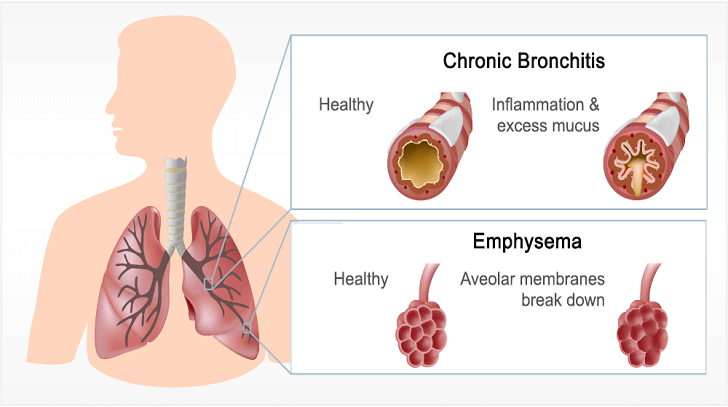Chronic bronchitis or else known as a chronic obstructive pulmonary disease (COPD) is characterized by worsening breathing once the airways are blocked. A person comes across difficulty breathing, and may no longer be able to withstand continuous cough during the daytime as well as at night. Typically, it may be manifested by a cough accompanied by excessive sputum production. When not treated, chronic bronchitis leads to acute exacerbations of its symptoms which last for several days, weeks, or even months. The best approach to this disease is the prevention of worsening and immediate treatment protocol when chronic bronchitis is crude. Once acute exacerbations are on, one may turn to pharmacological ways of dealing with it prescribed by the healthcare provider. Let’s cover the possible roots of this disease, and find the best meds which may greatly assist the treatment.
Triggers of Acute Exacerbations of Chronic Bronchitis (AECB)

The vast majority of patients acquire this disease due to infection including viral and bacterial factors. As for minorities, patients may come across it because of environmental factors when living in areas located nearby factories, refineries where the air is polluted. Then, COPD is notorious among smokers. As for the age distributions, people over 45 years are at the great risk of suffering from difficulty breathing, however, more and more young people may face this problem as well.
Among other causes are allergens including to pollen or wood, improper use of designated inhalers, and impact of other toxins and chemicals.
Treatment of AECB
AECB is usually classified per mild, moderate, and severe stages. Depending on the condition, there are several treatment protocols applied by one’s doctor. Once a mild stage is diagnosed, a doctor is most likely to prescribe short-acting bronchodilators (SABDs) which are quick-relievers used to unblock airways during the asthma attacks or cough. Moderate AECB is responding to SABDs in conjunctions with antibiotics as well as oral corticosteroids which reduce inflammation of the airways. Finally, the severe stage of the disease is hard to approach and may lead to fatal consequences. The patient is urgently directed to the hospital where receives complex treatment protocol, although, the prognosis of recovery is very low. The doctor may turn to oxygen or mechanical ventilation to help the patient receive enough air to breathe.
Helpful Meds for AECB

Even though SABDs is the first choice of patients who only start experiencing difficulty breathing, it is dangerous to take them without receiving a doctor’s approval. There are certain dosages and regimens of taking these drugs that may be tailored individually per each patient. If you believe your chronic bronchitis went too far from a simple cough, you should undergo a medical examination and receive the right directions on the treatment protocol. Beyond that, some SABDs and antibiotics are not considered solutions dispensed at affordable prices, so you may need to turn to generic formulations or online help. After receiving the treatment plan from the doctor, examine the Internet market of meds. At family pharmacy, a Canadian prescription service staffed by professionals in the pharmacological sphere, you may find drugs for treating bacterial infections at reduced prices as well as receive expert counseling on solutions that you may save your money with. Though, ensure to understand your doctor’s directions for AECB treatment.
What are the exact meds for this disease? As for SABDs for mild stages, the patient is most likely to be prescribed Albuterol which helps to manage excessive cough, wheezing, and which in generic forms may be used for nebulizers. Metaproterenol is a medication that treats chest tightness. Furthermore, the USA market avails for sale Levalbuterol and Pirbuterol.
Finally, some of the most-prescribed medications for AECB are also Azithromycin, Amoxicillin, Clarithromycin. These antibiotics perfectly suppress bacterial infections and help to relieve the difficulty of breathing. They work by stopping the widespread of bacteria, although they fit only moderate and severe stages of the disease, while mild AECB won’t respond well to any type of antibiotics.
Other prescribed medications include Cefuroxime axetil, Cefpodoxime, Cefdinir, Doxycycline, Moxifloxacin, Levofloxacin, and a vast majority of cough suppressants which may help you relieve coughing in the most inappropriate situations, for example, when your work requires concentration, and silence.
Prevention and Accompanying Methods to Alleviate AECB
If the moderate and severe stages of AECB are hard and prohibited to treat at sole discretion, mild stages may be accompanied by additional methods which may fasten the recovery. Beyond that, if you are a heavy smoker and believe the area you live is exposed to risks which may accelerate your difficulty breathing, follow the next advice:
- Minimize smoking. Yes, quitting at once is a hard-nut-to-crack, especially if you have a smoking history of 10+ years, however, a gradual reduction of this habit may help you escape the onset of chronic bronchitis with its acute exacerbations;
- Avoid dust. Dust is a massive irritant which may easily block your airways. Dedicate more time on cleaning your home. If you work in dusty areas, do not forget about mask which should always cover your nose and mouth;
- Think about annual immunization. Usually, such a medical practice is ongoing once a year. Depending on your particular case, you may also receive a few injections that will drop the risk of worsening breathing;
- Your lungs should be capable of breathing in full, strange it may sound. Spend time on jogging or swimming which may increase the capacity of your lungs;
- Quarantine yourself from people who currently have respiratory diseases.
Now, you have a clean-cut scheme on the treatment and prevention of AECB, however, it is worth recommending that every your consideration on the management of this disease should be discussed with the healthcare provider to avoid negative consequences. Do not take the first symptoms of difficulty breathing easy. The earlier you equip yourself with the doctor’s directions, the faster you will breathe with your full lungs with no trouble.